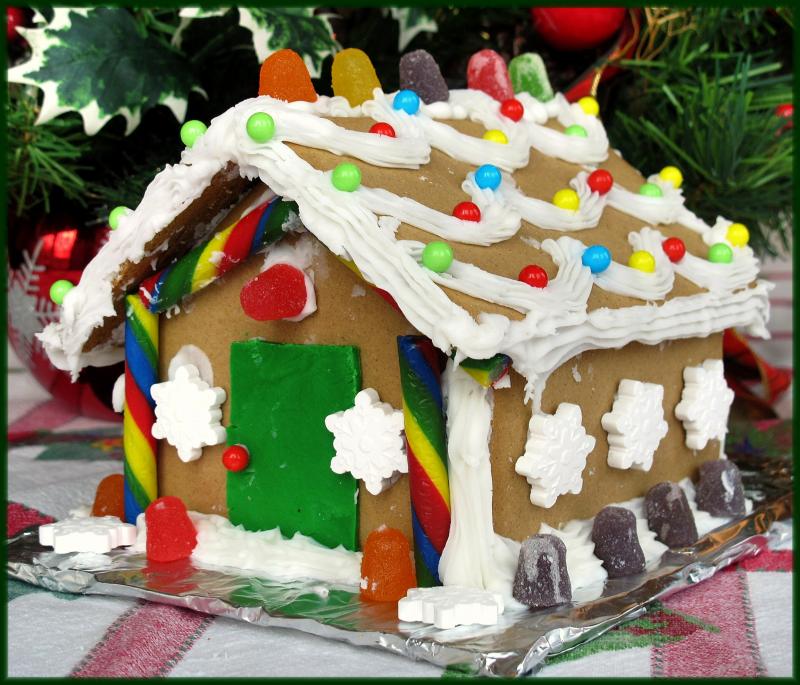It’s the season of gingerbread
Each year, as the holiday season approaches, I look forward to seeing festive gingerbread houses in shop windows, restaurants and bakeries. This year, I decided to try and make one myself. Since I wasn’t quite ready to bake my own siding and roof shingles, I purchased a kit made by Wilton, well-known for their cake decorating tools and supplies. Underneath a photo of a pretty gingerbread house, the box advertised “comes with everything you see here!”
Gingerbread has been around since the time of the ancient Greeks, originally imprinted with images for use in religious ceremonies. Food historians speculate an Armenian monk brought gingerbread to Europe in the 10th century, where it continued to be associated with religious icons. This baking practice was deemed so sacred and prestigious by European royalty, they only permitted gingerbread prepared by specially-trained members of the Gingerbread Guild.
During the Middle Ages, gingerbread cookies gilded with gold leaf were featured at festivals that came to be called Gingerbread Fairs. Queen Elizabeth was said to have asked for cookies resembling various dignitaries visiting her court, while German bakers are credited with the invention of the gingerbread house, using a form of pastry that was harder and sturdier, giving them the ability to create taller and more complex structures.
Eventually these elaborate cookie-walled houses, decorated with icing and candies, became associated with Christmas.
When I opened my gingerbread-kit, I found six pieces of hard gingerbread, colored candy balls the size of tiny peas, some gumdrops, a foil packet labeled “green fondant” and a generous supply of white icing. Unfortunately, one of the roof pieces had cracked across the middle and some of the siding edges were crumbly. Apparently, I wasn’t the first to experience this problem, which was addressed in the “helpful hints” under the heading “Don’t worry.”
I should have been a little wary of the instructions, the opening lines of which read “be sure to start assembling your train 3 to 4 hours before you want to decorate.” The remainder of the descriptions for building the train (or house) were equally vague, except for the precise 2 centimeters to cut from the tip of the icing bag. Based on my experience, I would recommend you assemble the house and let it sit overnight before adding decorations.
While attaching the panels to each other, have several heavy cans on hand to help prop the vertical panels. Make sure the cans aren’t too tall, or they’ll get in the way when you try to add the roof. Also, be prepared to have an immovable house, since you’ll need to apply icing (which serves as edible glue) on the edges along the bottom. The best sequence of assembly is the right angles of front to sides, followed by back and roof.
Be generous with the icing glue along the ridge line, as the slanted roof panels want to separate and slide down instead of staying in place. In fact, be generous with the icing everywhere; it will look like snow when you’re finished and the more you use the better your chances of building a house that doesn’t fall apart. There were no instructions for adding decorations, so I simply imitated the design on the box.
After this experience, I would offer a few suggestions to those of you thinking about making a gingerbread house. If you plan to eat it, don’t buy a kit, as there are so many additives and preservatives. Instead look for a trustworthy recipe site with lots of photos that will give you the best instructions. I found a great tutorial and detailed recipe on thespruceeats.com.
If you have children or grandchildren in town later this month, the Lewes Public Library is offering a Gingerbread House Making Workshop Saturday, Dec. 15, from 2:30 to 4 p.m. Call the library at 302-645-2733 to register. And, if you’d like to make the process even simpler, go with a graham cracker house like the one on happinessishomemade.net.
I debated about what recipe to share with you this week, since there are so many good sources of gingerbread house instructions (as well as kits for sale).
Instead of the hardtack-style cookies or house panels, here’s a recipe for a dense, delicious gingerbread with a cake-like consistency. This is wonderful with vanilla ice cream.
Gingerbread
2 C flour
1 t baking soda
1/4 t salt
1 T ginger
1/2 t cloves
2 t cinnamon
1 egg
1/2 C brown sugar
1/2 C melted butter
2 oz semisweet chocolate, melted
1/2 C buttermilk
1 C molasses
Preheat oven to 350F. Coat the inside of a 9-inch square baking pan with nonstick cooking spray; set aside. Sift together flour, baking soda, salt, ginger, cloves and cinnamon; set aside. In a large mixing bowl whisk together egg, brown sugar, melted butter, melted chocolate and buttermilk. Add molasses and stir to blend. Add dry ingredients and stir just until combined. Pour into prepared pan and bake until a tester comes out clean, about 35 to 40 minutes. Allow to cool before slicing.






















































